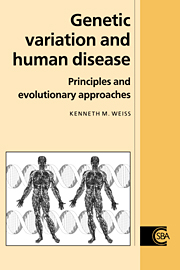Book contents
- Frontmatter
- Contents
- Frontispiece
- Preface: what is this book all about?
- Notational conventions used in this book
- List of abbreviations
- Part I Genes and their expression
- 1 What is a gene?
- 2 The logic of the genome
- 3 Concepts of frequency and association in populations
- 4 Genes and phenotypes in populations
- Part II Introduction to genetic epidemiology: inference from observational data
- Part III Evolution: the time dimension in populations
- Part IV Modification of the inherited genotype: the time dimension in individuals
- Afterwords: towards a unified general model
- References
- Index
3 - Concepts of frequency and association in populations
from Part I - Genes and their expression
Published online by Cambridge University Press: 05 June 2012
- Frontmatter
- Contents
- Frontispiece
- Preface: what is this book all about?
- Notational conventions used in this book
- List of abbreviations
- Part I Genes and their expression
- 1 What is a gene?
- 2 The logic of the genome
- 3 Concepts of frequency and association in populations
- 4 Genes and phenotypes in populations
- Part II Introduction to genetic epidemiology: inference from observational data
- Part III Evolution: the time dimension in populations
- Part IV Modification of the inherited genotype: the time dimension in individuals
- Afterwords: towards a unified general model
- References
- Index
Summary
How common is a phenotype in a population? How often does it arise? This chapter introduces some basic concepts of the impact or ‘frequency’ of phenotypes and of the relationship between that and the frequency of genes which may help to produce them.
Basic concepts of trait frequency and risk
Static measures: prevalence and its use as a probability
We can denote by φ the phenotype that we observe on an individual. The prevalence, or frequency, Pr(φ), of a specific phenotype at any given time is the fraction of individuals in a specified population who have the trait, equal to the probability that a randomly sampled individual has that phenotype. A phenotype can usually take on a range of possible values, and over this range Pr(φ) gives the phenotype distribution. Since every person must have exactly one phenotype, the prevalences over the acceptable range must sum to unity.
A phenotype can be a continuous measure such as the level of blood glucose, for which we can write the prevalence of a given glucose level, for example, as Pr(100 mg/dl). Or, a phenotype can be a qualitative trait such as the presence or absence of a disease, which we can denote φ = 1 (presence) and φ = 0 (absence). The term prevalence usually refers to the fraction of individuals who have the trait and is denoted Pr(φ = 1), or when the context is unambiguous just by Prev.
- Type
- Chapter
- Information
- Genetic Variation and Human DiseasePrinciples and Evolutionary Approaches, pp. 37 - 51Publisher: Cambridge University PressPrint publication year: 1993



